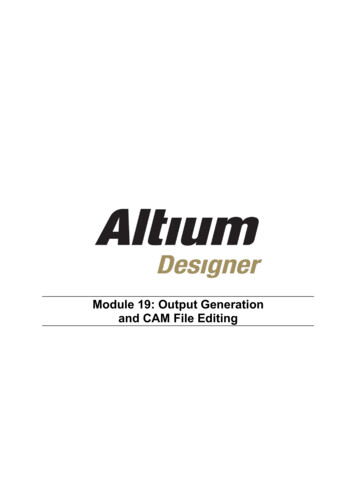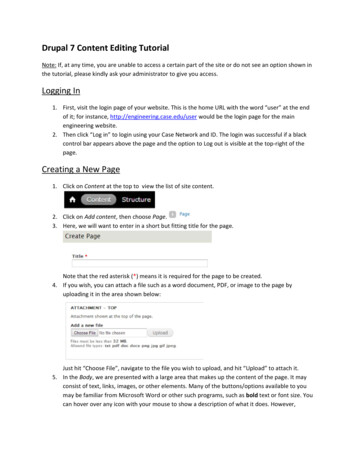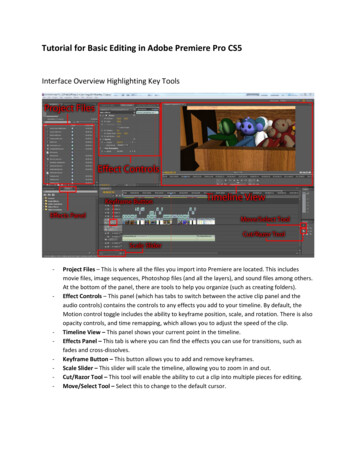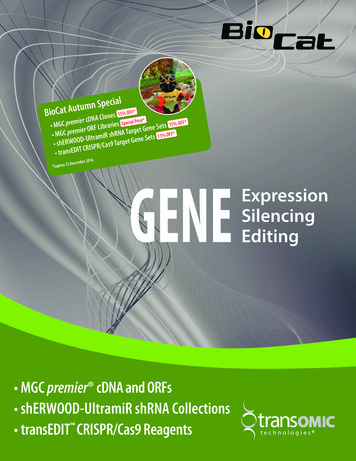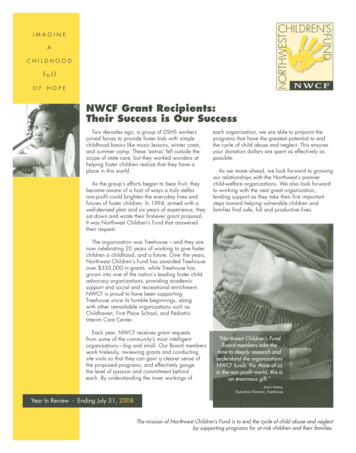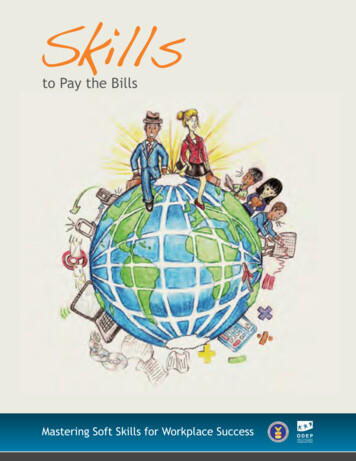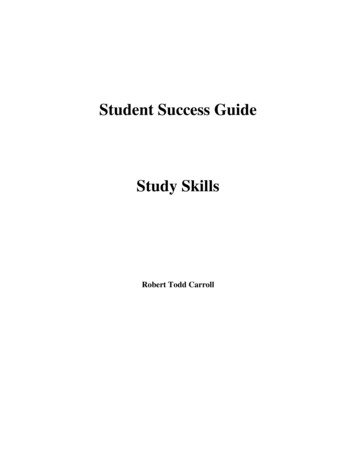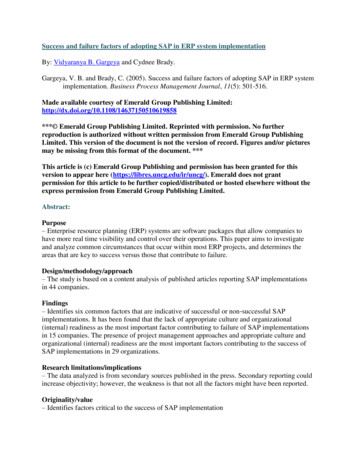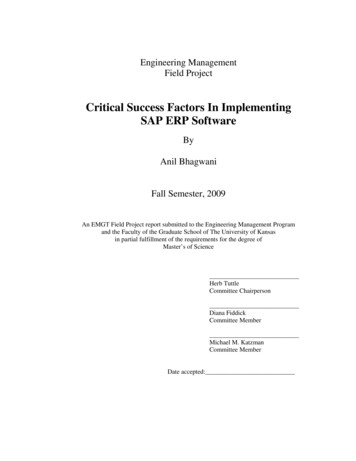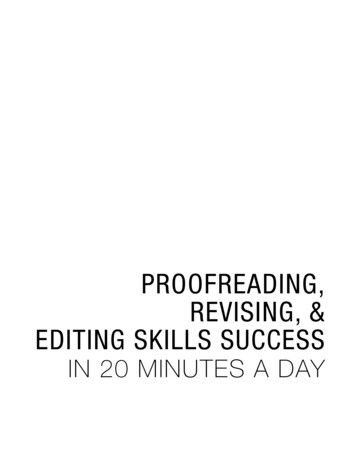
Transcription
PROOFREADING,REVISING, &EDITING SKILLS SUCCESSIN 20 MINUTES A DAY
PROOFREADING,REVISING, &EDITINGSKILLSSUCCESSIN 20 MINUTESA DAY Brady SmithN E WY O R K
Copyright 2003 LearningExpress, LLC.All rights reserved under International and Pan-American Copyright Conventions.Published in the United States by LearningExpress, LLC, New York.Library of Congress Cataloging-in-Publication Data:Smith, Brady.Proofreading, revising, and editing skills : success in 20 minutes a day /Brady Smith.—1st ed.p. cm.ISBN 1-57685-466-31. Report writing—Handbooks, manuals, etc. 2. Proofreading—Handbooks,manuals, etc. 3. Editing—Handbooks, manuals, etc. I. Title.LB1047.3.S55 2003808'.02—dc212002013959Printed in the United States of America9 8 7 6 5 4 3 2 1First EditionISBN 1-57685-466-3For more information or to place an order, contact LearningExpress at:55 Broadway8th FloorNew York, NY 10006Or visit us at:www.learnatest.com
About the AuthorBrady Smith teaches English at Adlai E. Stevenson High School in the Bronx, New York. His work has been previously published in textbooks, and this is his first complete book. He would like to dedicate this book to Julie,Gillian, and Isabel, with love.
ContentsINTRODUCTION How to Use This BookixPRETEST1LESSON 1Understanding the Writing Process13LESSON 2Writing Sentences21LESSON 3Avoiding Awkward Sentences33LESSON 4Creating Sentence Variety41LESSON 5Shaping Paragraphs49LESSON 6Using Transitions57LESSON 7Establishing a Writing Style63LESSON 8Turning Passive Verbs into Active Verbs75LESSON 9Making Sure Subjects and Verbs Agree83LESSON 10Making Sure Nouns and Pronouns Agree91LESSON 11Using Modifiers99LESSON 12Checking Capitalization and Spelling109LESSON 13Punctuating Sentences121LESSON 14Using Commas127LESSON 15Using Semicolons and Colons137LESSON 16Using Apostrophes in Plurals and Possessives143LESSON 17Using Quotation Marks147LESSON 18Using Hyphens, Dashes, and Ellipses153vii
LESSON 19Checking for Commonly Confused Words and Clichés161LESSON 20Putting It All Together169POST-TESTAPPENDIX A179Proofreading Symbols189APPENDIX B Additional Resources191viii
How to UseThis BookSince you are reading this right now, let us assume you have at least one draft of your writingthat you want to proofread, revise, and edit in order to present a well-written and clear finished piece. As all good writers know, a first draft needs to be cleaned up, trimmed down, andorganized. This book is designed to help you do just that—in 20 short lessons in just 20 minutes a day.This book stands alone as a teaching tool. You can pick it up and learn a new skill at any point duringthe writing process. Whether you are prewriting, drafting, editing, revising, or working on a final copy, thisbook will become a useful reference guide. You may find it helpful to turn to this book as you finish different sections of your writing because it can help you correct as you write. Or you can read the lessons in thisbook and then go back to your own piece of writing—just to reinforce important writing skills. No matterwhich method you choose, you will accomplish what you set out to do: master the skills you need to proofread, revise, and edit your writing.Proofreading, Revising, and Editing Skills Success in 20 Minutes a Day begins with a discussion aboutthe steps to create a piece of writing, and then gives you the coaching you will need to correct any errorsyou find in your work. It walks you through the revision process by showing you how to transform yoursentences from awkward and choppy sentence fragments and run-ons to clear, concise expressions. It showsix
–H O W T O U S E T H I S B O O K –If you are job hunting, perhaps you need torevise a draft of a cover letter. This piece of writing isthe first impression your employer will have of you, soit’s important to submit your best effort. Perhaps youare working on an essay for school. Your teacher’sassessment of your abilities will certainly improve ifyou turn in a composition that shows thoughtful revision, attention to detail, and an understanding ofgrammatical rules.Like your ideal final draft, Proofreading, Revising,and Editing Skills Success in 20 Minutes a Day has nofiller or fluff. It is a book for people who want to learnthe editorial skills needed to revise a piece of writingwithout doing a lot of busy work. Each lesson introduces a skill or concept and offers exercises to practicewhat you have learned.Though each lesson is designed to be completedin about 20 minutes, the pace at which you approachthe lessons is up to you. After each lesson, you maywant to stop and revise your own writing, or you maywant to read several lessons in one sitting and thenrevise your work. No matter how you use this book,you can be sure that your final drafts will improve.Start by taking the pretest to see what you alreadyknow and what you need to learn about proofreading,revising, and editing. After you have completed the lessons, you can take the post-test to see how much youhave learned. In the appendices, you will find a list ofproofreading marks to use as you write, as well as a listof additional resources if you find you need a littleextra help.If you apply what you have learned in this book,you will find that your writing gets positive attention.Teachers, employers, friends, and relatives will allnotice your improvement. It is certain, though, thatyou will be the most satisfied of all.you how to organize paragraphs and how to use transitions skillfully. You will also learn the fundamentalrules of noun/pronoun agreement as well as subject/verb agreement. When you are finished with thisbook, you will find that your writing has improved,has style and detail, and is free of cluttered sentencesand common errors.Some writers think that once a word has beenwritten, it is sacred. Successful writers know thatchange is an important part of the writing process.Early drafts that may seem finished can most likely beimproved. Since writing is a process, you have to bewilling to change, rearrange, and discard material toachieve a well-crafted final product. Very few writerscreate the perfect draft on the first try. Most writerswill tell you that writing the first draft is only thebeginning and that the majority of the work comesafter the initial drafting process. You need to look veryclosely at your writing, examine it sentence by sentence, and fine-tune it to produce excellence.Your writing is a reflection of you. The proofreading, revising, and editing processes provide a mirrorin which you can examine your writing. Before yourwriting goes public, you must iron out the transitionsbetween ideas and make sure your paragraphs are structured correctly. You need to clean up your writing andpick out the unnecessary auxiliary verbs from your sentences, perfect your tone, and polish your verbs. Yourefforts will show.Even if you are not currently working on a pieceof writing that you need to hand in, present to an audience, or send to a client, this book will teach you theskills that will improve your everyday writing. Eachskill outlined in this book is an important part of agood writer’s “toolbox.” While you will not use everytool for each piece of writing, you will have them readywhen you need to apply them.x
PROOFREADING,REVISING, &EDITING SKILLS SUCCESSIN 20 MINUTES A DAY
PretestBefore you begin the lessons in this book, it is a good idea to see how much you already knowabout proofreading, revising, and editing and what you need to learn. This pretest is designedto ask you some basic questions so you can evaluate your needs. Knowing your ownstrengths and weaknesses can help you focus on the skills that need improvement.The questions in this pretest do not cover all the topics discussed in each lesson, so even if you cananswer every single question in this pretest correctly, there are still many strategies you can learn in order tomaster the finer points of grammar and style. On the other hand, if there are many questions on the pretestthat puzzle you, or if you find that you do not get a good percentage of answers correct, don’t worry. Thisbook is designed to take you through the entire proofreading, editing, and revising process, step-by-step.Each lesson is designed to take 20 minutes, although those of you who score well on the pretest mightmove more quickly. If your score is lower than you would like it to be, you may want to devote a little morethan 20 minutes of practice each day so that you can enhance your skills. Whatever the case, continue withthese lessons daily to keep the concepts fresh in your mind, and then apply them to your writing.An answer sheet is provided for you at the beginning of the pretest. You may mark your answers there,or, if you prefer, circle the correct answer right in the book. If you do not own this book, number a sheet of1
–P R E T E S T –sponding lesson. If you answer a question incorrectly, turn to the chapter that covers that particular topic, read the information, and then try toanswer the question according to the instructiongiven in that chapter.paper from 1–50 and write your answers there. Thisis not a timed test. Take as much time as you need,and do your best. Once you have finished, checkyour answers with the answer key at the end of thistest. Every answer includes a reference to a corre-2
–A N S W E R S H E E T bbccccccccccdddddddddd
–P R E T E S T –5. Which of the underlined words in the following sentence is an unnecessary qualifier orintensifier?Many experts consider the stained glass inthat church to be the very best.a. expertsb. stainedc. thatd. very1. Which of the following is a completesentence?a. Because night fell.b. Jim ate the sandwich.c. On a tree-lined path.d. In our neck of the woods.2. Which of the following sentences is correctlypunctuated?a. In the dead of night. The van pulled up.b. Chuck would not, give Jaime the seat.c. Over coffee and toast, Kelly told me abouther new job.d. Lemonade. My favorite drink.6. Determine whether the italicized phrase in thefollowing sentence is a participial phrase, agerund phrase, an infinitive phrase, or anappositive phrase.Having missed the bus, Allen knew hewould be late for work.a. participial phraseb. gerund phrasec. infinitive phrased. appositive phrase3. Which of the following sentences correctlyuses a conjunction?a. I cannot play in the game until I practicemore.b. I hid in the basement my brother was madat me.c. Victor erased the answering machine message Nora would not find out.d. She scored a goal won the game.7. Choose the best conjunction to combine thissentence pair.We can ask directions. We can use a map.a. andb. butc. ord. because4. Which of the underlined words or phrases inthe following sentence could be deleted without changing the meaning?Various different companies offer incentiveplans to their employees.a. differentb. incentivec. plansd. employees8. The following sentence pair can be revisedinto one better sentence. Choose the sentencethat is the best revision.The bicycle tire is flat. The bicycle tire is onthe bike.a. The bicycle tire is on the bike and the bicycle tire is flat.b. The flat bicycle tire is on the bike.c. On the bike, the bicycle tire there is flat.d. The bicycle tire on the bike is flat.5
–P R E T E S T –12. Which of the underlined words in the following sentence is considered transitional?We did not catch any fish; as a result, we atemacaroni and cheese.a. did notb. anyc. as a resultd. and9. Choose the sentence that begins with a phrasemodifier.a. He kept his bottle cap collection in a shoebox.b. In the event of an emergency, do not panic.c. I was pleased to see that my coworker hadbeen promoted.d. The octopus has been at the zoo for 20years.13. Which of the underlined words in the following paragraph is a transition word?A National Park Service employee annuallyinspects the famous Mount RushmoreNational Memorial near Keystone, SouthDakota. He uses ropes and harnesses to take aclose look at the 60-foot granite heads ofGeorge Washington, Theodore Roosevelt,Thomas Jefferson, and Abraham Lincoln. If hefinds a crack, he coats it with a sealant,thereby preventing moisture from cracking itfurther.a. annuallyb. nearc. andd. thereby10. Select the letter for the topic sentence in thefollowing paragraph.a. He was born in 1818. b. He was educatedin the universities of Moscow and St. Petersburg. c. In 1852, he abandoned poetry anddrama and devoted himself to fiction. d. IvanTurgenev was a critically acclaimed Russianauthor.11. Identify the type of organizational structureused in the following paragraph: chronological order, order of importance, spatial order,or order of familiarity.When you enter the mansion, the great hallhas three ornate doorways and a grand staircase. The doorway to the left leads to thekitchen area, the doorway to the right leads tothe library, and the doorway straight aheadleads to the formal dining room. The staircasecurves up to the second floor. Directly aboveyou will see the famous “Chandelier de Grouton,” with over 4,000 crystals shaped liketeardrops.a. chronological orderb. order of importancec. spatial orderd. order of familiarity14. Identify the purpose of a composition withthe following title:“Good Reasons to Always Drive Safely”a. persuasiveb. expositoryc. narratived. descriptive15. Identify whether the following sentence is factor opinion.The voting age should be raised to 21.a. factb. opinion6
–P R E T E S T –20. Which of the following sentences does NOTuse passive voice?a. She is known by the whole town as the bestgoalie on the hockey team.b. The puck was hurled across the ice by thestar forward.c. She won the Best Player Award last winter.d. The women’s ice hockey team was foundedfive years ago.16. Which of the following sentences does NOTuse informal language?a. Everybody said his new car was a “sweetride.”b. Susanne totally couldn’t believe that shehad won the lottery.c. The letter arrived in the morning, and heopened it immediately.d. I always feel cooped up in my cubicle atwork.21. Identify the correct verb for the blank in thefollowing sentence.Laura and her friend for their trip toPeru in an hour.a. leavesb. leave17. Identify the appropriate type of language touse in a letter requesting information from agovernment agency.a. formalb. informal22. Identify the correct contraction for the blankin the following sentence.Jake and Mariela have to worktonight?a. Don’tb. Doesn’t18. Which of the following sentences uses theactive voice?a. Peter was given a laptop to use when heworked at home.b. The mountain was climbed by several ofthe bravest hikers in the group.c. The favors for the birthday party were provided by the restaurant.d. Randy and Thien won the egg toss at thestate fair.23. Identify the correct verb for the blank in thefollowing sentence.We, the entire student body, including onestudent who graduated mid-year, theschool colors to remain green and black.a. wantsb. want19. Which of the following sentences uses theactive voice?a. Several ingredients were used by the chef tomake the stew.b. The chef used several ingredients to makethe stew.b. To make the stew, several ingredients wereused.b. The stew was made by the chef using several ingredients.24. Identify the correct verb for the blank in thefollowing sentence.A committee policy in all matters ofevaluation.a. determinesb. determine7
–P R E T E S T –31. Identify the correct word for the blank in thefollowing sentence.The boy told his teacher that he did notperform in the concert because hewas sick.a. goodb. well25. Identify the correct verb for the blank in thefollowing sentence.Neither the bus driver nor the passengersthe new route.a. likesb. like26. Identify the correct pronoun(s) for the blankin the following sentence.Anybody can learn to make own website.a. his or herb. their32. Identify the correct word for the blank in thefollowing sentence.That was a good milkshake.a. realb. really33. Identify the correct word for the blank in thefollowing sentence.Of the three sweaters, I like the red one.a. betterb. best27. Identify the correct pronoun for the blank inthe following sentence.I often think of Andra and .a. sheb. her28. Identify the correct pronoun for the blank inthe following sentence.My brother and used to play pingpong together every day.a. Ib. me34. Identify the sentence that uses capitalizationcorrectly.a. In the movie, David had a difficult time incuba.b. in the movie, David had a difficult time inCuba.c. In the Movie, David had a difficult time inCuba.d. In the movie, David had a difficult time inCuba.29. Identify the correct word for the blank in thefollowing sentence.Tirso made the basket .a. easyb. easily35. Identify the sentence that uses capitalizationcorrectly.a. The whole family appreciated the letterSenator Clinton sent to Uncle Jeff.b. The whole Family appreciated the lettersenator Clinton sent to Uncle Jeff.c. The whole family appreciated the letterSenator Clinton sent to uncle Jeff.d. The whole family appreciated the lettersenator Clinton sent to uncle Jeff.30. Identify the correct word for the blank in thefollowing sentence.His black eye looked .a. badb. badly8
–P R E T E S T –41. Which of the following sentences is punctuated correctly?a. Sadly, I walked home.b. Sadly I walked home.c. Sadly I walked, home.d. Sadly, I walked, home.36. Identify the sentence that uses capitalizationcorrectly.a. On Friday, it was Chinese New Year, so wewent to Yien’s restaurant to celebrate.b. On friday, it was Chinese new year, so wewent to Yien’s Restaurant to celebrate.c. On Friday, it was Chinese New Year, so wewent to Yien’s Restaurant to celebrate.d. On Friday, it was Chinese new year, so wewent to Yien’s restaurant to celebrate.42. Which of the following sentences is punctuated correctly?a. When Yoshiro saw the beautiful cabin; bythe lake, he was happy too.b. When Yoshiro saw the beautiful, cabin bythe lake he was happy, too.c. When Yoshiro saw the beautiful cabin, bythe lake, he was happy, too.d. When Yoshiro saw the beautiful cabin bythe lake, he was happy, too.37. Identify the sentence that uses capitalizationcorrectly.a. I plan to go to Canada this summer towatch the Calgary stampede.b. I plan to go to canada this Summer towatch the Calgary Stampede.c. I plan to go to Canada this summer towatch the Calgary Stampede.d. I plan to go to Canada this Summer towatch the Calgary Stampede.43. Which of the following sentences is punctuated correctly?a. Ms. Lundquist my second grade teacher haswritten a very helpful book.b. Ms. Lundquist my second grade teacher,has written a very helpful book.c. Ms. Lundquist, my second grade teacher,has written a very helpful book.d. Ms. Lundquist, my second grade teacherhas written a very helpful book.38. Identify the correct word for the blank in thefollowing sentence.We parked , but we still received aticket.a. Legallyb. legally44. Which of the following sentences is punctuated correctly?a. The Little League baseball fields near SanDiego California are clean and well-lit.b. The Little League baseball fields near SanDiego, California, are clean and well-lit.c. The Little League baseball fields near SanDiego, California are clean and well-lit.d. The Little League baseball fields near SanDiego, California are clean, and well-lit.39. Which of the following sentences is punctuated correctly?a. My appt. with Dr. Nayel is at 5:15 P.M.b. My appt. with Dr Nayel is at 5:15 P.M.c. My appt. with Dr. Nayel is at 5:15 PM.d. My appt with Dr. Nayel is at 5:15 PM40. Which of the following sentences is punctuated correctly?a. Have the paychecks arrived yet.b. Have the paychecks arrived yet?b. Have the paychecks arrived yet!b. Have the paychecks, arrived yet?9
–P R E T E S T –48. Which of the following sentences is punctuated correctly?a. All thirty two nine year old students carriedtwenty pound backpacks.b. All thirty-two nine year old students carried twenty-pound backpacks.c. All thirty two nine-year-old students carried twenty-pound-backpacks.d. All thirty-two nine-year-old students carried twenty-pound backpacks.45. Which of the following sentences is punctuated correctly?a. At 3:45 P.M., Freddy will umpire the varsitygame, Tomas, the junior varsity game, andFederico, the freshman game.b. At 345 PM, Freddy will umpire the varsitygame; Tomas, the junior varsity game; andFederico, the freshman game.c. At 3:45 P.M. Freddy, will umpire the varsitygame, Tomas, the junior varsity game, andFederico, the freshman game.d. At 3:45 P.M., Freddy will umpire the varsitygame; Tomas, the junior varsity game; andFederico, the freshman game.49. Identify the correct words for the blank in thefollowing sentence.I would like to have the party moreat a restaurant.a. hear, thanb. hear, thenc. here, thand. here, then46. Which of the following sentences is punctuated correctly?a. The bookstore had to move its collection ofchildren’s books.b. The bookstore had to move it’s collectionof childrens’ books.c. The bookstore had to move its’ collectionof children’s books.d. The bookstore had to move its’ collectionof childrens’ books.50. Identify the correct words for the blanks inthe following sentence.We put on our uniforms, but we stilllate for the game.a. already, maybeb. already, may bec. all ready, maybed. all ready, may be47. Which of the following sentences is punctuated correctly?a. The professor asked, “Has anybody read ‘AGood Man Is Hard to Find’?”b. The professor asked “has anybody read ‘AGood Man Is Hard to Find’?”c. The professor asked, “Has anybody read “AGood Man Is Hard to Find”?”d. The professor asked, “has anybody read ‘AGood Man Is Hard to Find?’ ”10
–P R E T E S T – Answers1. b. Lesson 226. a. Lesson 102. c. Lesson 227. b. Lesson 103. a. Lesson 228. a. Lesson 104. a. Lesson 329. b. Lesson 115. d. Lesson 330. a. Lesson 116. a. Lesson 331. b. Lesson 117. c. Lesson 432. b. Lesson 118. d. Lesson 433. b. Lesson 119. b. Lesson 434. d. Lesson 1210. d. Lesson 535. a. Lesson 1211. c. Lesson 536. c. Lesson 1212. c. Lesson 637. c. Lesson 1213. d. Lesson 638. b. Lesson 1214. a. Lesson 739. a. Lesson 1315. b. Lesson 740. b. Lesson 1316. c. Lesson 741. a. Lesson 1417. a. Lesson 742. d. Lesson 1418. d. Lesson 843. c. Lesson 1419. b. Lesson 844. c. Lesson 1420. c. Lesson 845. d. Lesson 1521. b. Lesson 946. a. Lesson 1622. a. Lesson 947. a. Lesson 1723. b. Lesson 948. d. Lesson 1824. a. Lesson 949. c. Lesson 1925. a. Lesson 950. b. Lesson 1911
L E S S O N1Understandingthe WritingProcessLESSON SUMMARYIn order to proofread, revise, and edit you need to understand thewriting process—from prewriting to drafting, editing, revising, and writing a final draft. This lesson discusses the writing steps and then givesyou strategies to help you write the best possible final draft.The writing process has only just begun when you write the last word of your first draft. It is inthe process of revising and editing that the draft takes shape and becomes a crafted piece ofwriting. Writing is an art, and like any good artist, a good writer continues to work on a pieceuntil it has the desired impact. Prewriting/BrainstormingFirst, it is important to figure out what you know about a topic. Since many ideas come to mind when youbegin to think about a topic, take time to write them down. First thoughts are easily forgotten if they arenot committed to paper. You can do this with a prewriting technique such as brainstorming, clustering,mapping, or listing. You can use graphic organizers like charts, story maps, diagrams, or a cluster like theexample on the next page.Prewriting can take place in all sorts of inconvenient locations, and you may only have a napkin, a pieceof scrap paper, or an envelope on which to write. Just don’t think a napkin with scribbles on it is the finaldraft. You still have much work to do.13
–U N D E R S T A N D I N G T H E W R I T I N G P R O C E S S –M.L.K.workerscivil inationin the U.S.minorsvotingrecent immigrantsagemandatoryretirementslaverysexualequal ors DraftingThe next step is turning those thoughts into a firstdraft. Those of you who skip the prewriting stepand jump right into a first draft will find that theediting stage takes more time than it should. Youmay even find that you have changed your mindfrom the beginning to the end of a piece, or that thefirst paragraph is spent getting ready to say something. That’s fine, but be prepared to reorganizeyour entire draft.Writing with a plan makes the entire writingprocess easier. Imagine you are a famous writer ofmystery novels. If you don’t know whodunit, howcan you write the chapters that lead up to the partwhere the detective reveals the culprit? It is the samewith your writing. Without an organizational plan,the paper you write may not take the right shapeand may not say all you intended to say.R e v i s i n g A s Yo u G oMost writers revise as they write. That’s why pencilswith erasers were invented. If you are a writer whouses pen and paper, feel free to fill your first draftswith arrows and crossed-out words. You may continue a sentence down the margin or on the back ofthe page, or use asterisks to remind you of where youwant to go back and add an idea or edit a sentence.If you use a computer to compose, use symbols to remind you of changes that need to bemade. Put a questionable sentence in boldface ora different color so you can remember to return toit later. A short string of unusual marks like#@ *%! will also catch your eye and remind you toreturn to a trouble spot. Typing them may evenrelieve some of the tension you’re feeling as youstruggle with your draft. Just remember that ifyou’re planning to show your draft to someone,like a teacher or coworker, you may want to cleanit up a little first.Computers also make it easier to makechanges as you go, but remember that a computer’s14
–U N D E R S T A N D I N G T H E W R I T I N G P R O C E S S –Examplethe russian Ballet travel’s. all over the world, Performing to amazed Audiences. in each new city;grammar check or spell check is not foolproof.Computers do not understand the subtle nuances ofour living language. A well-trained proofreader oreditor can. This sentence jerks along like an old car drivenby someone who doesn’t know how to use thebrakes.ProofreadingEdited ExampleThe Russian Ballet travels all over the world, performing to amazed audiences in each new city.Proofreading is simply careful reading. As youreview every word, sentence, and paragraph, youwill find errors. When you locate them, you can useproofreading symbols to shorten the amount oftime you spend editing. It is an excellent idea tobecome familiar with these symbols. At the bottomof this page are a few examples of the most commonones, but be sure to check Appendix A for a complete list.Of course, in order to find errors, you mustknow what they are. Read on to discover the culpritsthat can sabotage a good piece of writing. Every sentence begins with a capital letter.That’s the easy part. Many other words are capitalized, too, however, and those rules can be harder toremember. Lesson 12 reviews all the rules of capitalization for you.While every sentence begins with a capital letter, every sentence ends with some sort of punctuation. The proper use of end marks like periods,exclamation points, and question marks (Lesson13) and other punctuation like commas, colons,semicolons, apostrophes, and quotation marks(Lessons 14–17) will help your reader make sense ofyour words. Punctuation is often the differencebetween a complete sentence and a sentence fragment or run-on (Lesson 2). Other punctuationmarks like hyphens, dashes, and ellipses (Lesson 18)Capitalization andPunctuationCapitalization and punctuation are like automechanics for your writing. They tune up your sentences and make them start, stop, and run smoothly.SYMBOL/ .EXAMPLEMEANING OF SYMBOLStevenson High schoolCapitalize a lower-case letter./Make a capital letter lower-case. Insert a missing word, letter, or punctuationmark.the Second stringrightGo at the light.I had an an ideaDelete a word, letter, or punctuation mark.recieveChange the order of the letters. . . to the end .Add a period. . . apples oranges, and . . .Add a comma.15
–U N D E R S T A N D I N G T H E W R I T I N G P R O C E S S –give flare to your writing and should be used forfunction as well as style.ExampleHe read thru the entire paper looking for a storyon the protest march. Spell check suggests replacing “thru” with“through,” “threw,” or “thorough.” The dictionarywill tell you that the correct spelling is “through.”Choosing a suggested spelling from spellcheck that is incorrect in the context of your sentence can affect an entire piece. As teachers andemployers become more familiar with spell checkprograms, they learn to recognize when a writer hasrelied on spell check. For example, homonyms suchas pane and pain and commonly confused words,such as where, wear, and were (Lesson 19) present aproblem for spell check, just as they do for manywriters. Ultimately, there is no substitute for a dictionary and a set of trained eyes and ears.SpellingCorrect spelling gives your work credibility. Notonly will your reader know that you are educated,but also that you are careful about your work. Youshould have a dictionary handy to confirm that youhave correctly spelled all unfamiliar words, especially if they are key words in the piece. In the workplace, a memo with a repeatedly misspelled wordcan be embarrassing. An essay with a misspelledword in the t
and Editing Skills Success in 20 Minutes a Dayhas no filler or fluff. It is a book for people who want to learn the editorial skills needed to revise a piece of writing without doing a lot of busy work. Each lesson intro-duces a skill or concept and offers exercises to practice what you hav
